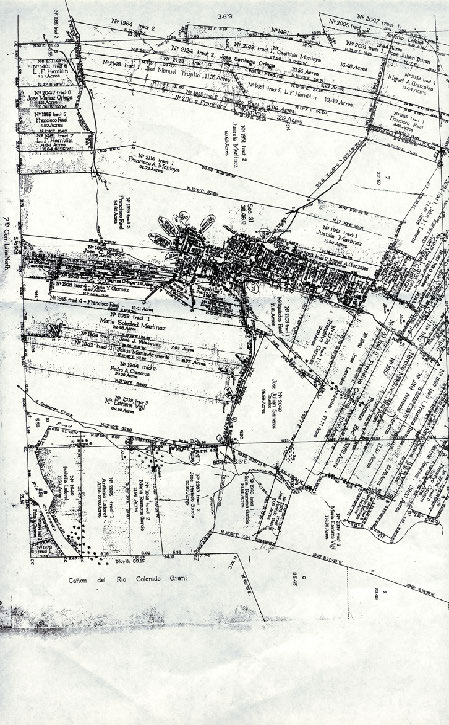As with many of these early private land claims, the U.S. Land office was hesitant to confirm the grants because of the vague wording of the grants. Because the Spanish thought land was not valuable, their land grants were made in large quantities and natural objects and landmarks, which disappeared over time, were provided as boundaries (see original grant for Rio Colorado on p. 41).

(map courtesy of John Rael)
Surveyors took advantage of these vague boundaries and expanded the bounds of grants even further. And unscrupulous land speculators took advantage of all of this in attempts to defraud the U.S. government of public lands. Under the Treaty of Guadalupe Hidalgo (1848), the U.S. government was to respect the validity of these grants if they had been valid under the laws of Spain and Mexico. The Office of the Surveyor-General was created in 1854 to determine the validity of the Spanish grants (179).
In 1874, Jose Antonio Laforet, grandson of Antonio Elias Armenta, presented a claim to the Surveyor General’s Office to validate the Cañon grant. The grant was transmitted to the U.S. Congress December 7, 1874, but no action was taken. (180). The Land Office instructions of 1885 required that these cases be referred back to the Surveyor General for re-examination. In the second presentation before the Surveyor General, the claim was rejected by Surveyor General George W. Julian on April 10, 1886.
He cited as grounds for the rejection the following: Jose Antonio Laforet had filed claiming to be the sole owner of the land, but no evidence was presented showing how he gained title to the land; documentary evidence of the original grant was not filed in the public record, there was no evidence of delivery of possession or of occupation; a letter from E.M. Ashley dated March 19, 1874, had been presented saying he had purchased an interest in the grant; the Taos officials had no authority to make the grant because the land did not belong to the Town of Taos. Julian explained that town authorities could only grant up to 50 varas, not the 49,939.21 acres being claimed here; only the Governor had authority to grant such large amounts of land.
A subsequent claim was presented to the Private Land Claims Court on March 3, 1893, by Clarence P. Elder, who had bought up most of the Cañon del Rio Colorado grant. Elder, in his petition, claimed he was the owner of the grant “…by purchase from the heirs and assigns of the said original grantees, and claims a perfect title to the same.” A series of deeds made during 1872–1875 appear to have passed title to the grant to Elder. The Court dismissed this petition for the grant on November 17, 1896. After a series of amended petitions were dismissed the case was appealed to the U.S. Supreme Court and on January 18, 1898, it was dismissed (181).

